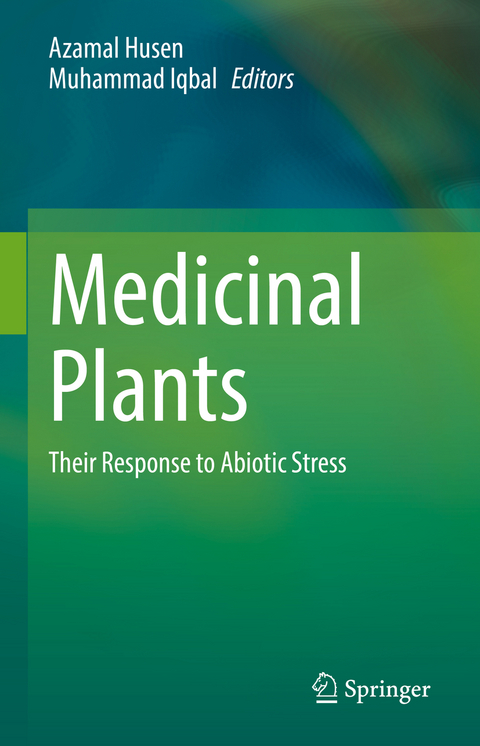
Medicinal Plants
Springer Verlag, Singapore
978-981-19-5610-2 (ISBN)
Professor Azamal Husen served as Professor & Head, Department of Biology, University of Gondar, Ethiopia and is a Foreign Delegate at Wolaita Sodo University, Wolaita, Ethiopia. He specializes in biogenic nanomaterial fabrication and application, plant responses to environmental stresses and nanomaterials at the physiological, biochemical and molecular levels, herbal medicine, and clonal propagation for improvement of tree species, and has published over 175 research articles. He is on the advisory board of Cambridge Scholars Publishing, UK. Husen has been on the Editorial Board and the panel of reviewers of several reputed journals published by Elsevier, Frontiers Media, Taylor & Francis, Springer Nature, RSC, Oxford University Press, Sciendo, The Royal Society, CSIRO, PLOS, MDPI, and John Wiley & Sons. He is a Fellow of the Plantae group of the American Society of Plant Biologists, and a Member of the International Society of Root Research, Asian Council of Science Editors, and INPST. He is Editor-in-Chief of the American Journal of Plant Physiology, and a Series Editor of Exploring Medicinal Plants (Taylor & Francis Group, USA); Plant Biology, Sustainability, and Climate Change (Elsevier, USA); and Smart Nanomaterials Technology (Springer Nature, Singapore). Professor Muhammad Iqbal worked at the Government PG College, Uttarkashi, Aligarh Muslim University, Aligarh, and Jamia Hamdard (Hamdard University), New Delhi. He was Professor & Head of Botany Department, Dean of Science Faculty, Chairman of Admission Committee, and also the Vice-Chancellor at Jamia Hamdard. He also worked as a Visiting Scientist in South Korea and Poland and as a Professor at the King Saud University of Riyadh, Saudi Arabia. Specializing in Developmental, Environmental, and Medicinal Botany, he has produced over 425 publications, including 10 books, 285 original research papers, 72 book chapters, and numerous technical reports,book reviews, and popular articles. In addition, over 220 abstracts of papers presented in botanical conferences go to his credit. A Fellow of seven prestigious scientific organizations, and a recipient of over a dozen academic awards, Iqbal has acted as President of the Academy of Environmental Biology (2006-2009), and Vice-President of the Indian Botanical Society (2003-2004) and the International Society of Environmental Botanists (2013-18). He has been the editor or a member of Editorial Board for 20 research journals of international repute, and a Series Editor of Plant Biology, Sustainability, and Climate Change (Elsevier, USA).
Chapter 1. Medicinal plants and abiotic stress: An overview.- Chapter 2. Medicinal plants proteomics in response to abiotic stresses.- Chapter 3. Medicinal plants metabolomics in response to abiotic stresses.- Chapter 4. Secondary metabolite production in medicinal plants under abiotic stress.- Chapter 5. Effect of temperature (cold and hot) stress on medicinal plants.- Chapter 6. Effect of water stress (drought and waterlogging) on medicinal plants.- Chapter 7. Effects of gaseous pollutants on medicinal plants.- Chapter 8. Impact of salinity stress on medicinal plants.- Chapter 9. Impact of aridity on specialized metabolism: Concentration of natural products in plants.- Chapter 10.The role of PGPRs in medicinal plants under abiotic stress.- Chapter 11. Effect of mineral nutrition and PGRs on biosynthesis and distribution of secondary plant metabolites under abiotic stress.- Chapter 12. Impact of phytoprotectants on growth and yield of medicinal plants under abiotic stress.- Chapter 13. Biostimulants and phytohormones improve productivity and quality of medicinal plants under abiotic stress.- Chapter 14. Light (high light/UV radiation) modulates adaptation mechanisms and secondary metabolite production in medicinal plants.- Chapter 15. Recent Strategies to engineer alkaloid biosynthesis in medicinal plants.- Chapter 16. Genome-editing strategies for enhanced stress tolerance in medicinal plants.- Chapter 16. Phytoremediation potential of medicinal plants.- Chapter 17. Phytoremediation potential of medicinal plants.
| Erscheinungsdatum | 01.02.2023 |
|---|---|
| Zusatzinfo | 1 Illustrations, black and white; XI, 469 p. 1 illus. |
| Verlagsort | Singapore |
| Sprache | englisch |
| Maße | 155 x 235 mm |
| Themenwelt | Medizin / Pharmazie ► Medizinische Fachgebiete ► Pharmakologie / Pharmakotherapie |
| Naturwissenschaften ► Biologie ► Botanik | |
| Technik ► Umwelttechnik / Biotechnologie | |
| ISBN-10 | 981-19-5610-3 / 9811956103 |
| ISBN-13 | 978-981-19-5610-2 / 9789811956102 |
| Zustand | Neuware |
| Informationen gemäß Produktsicherheitsverordnung (GPSR) | |
| Haben Sie eine Frage zum Produkt? |
aus dem Bereich


